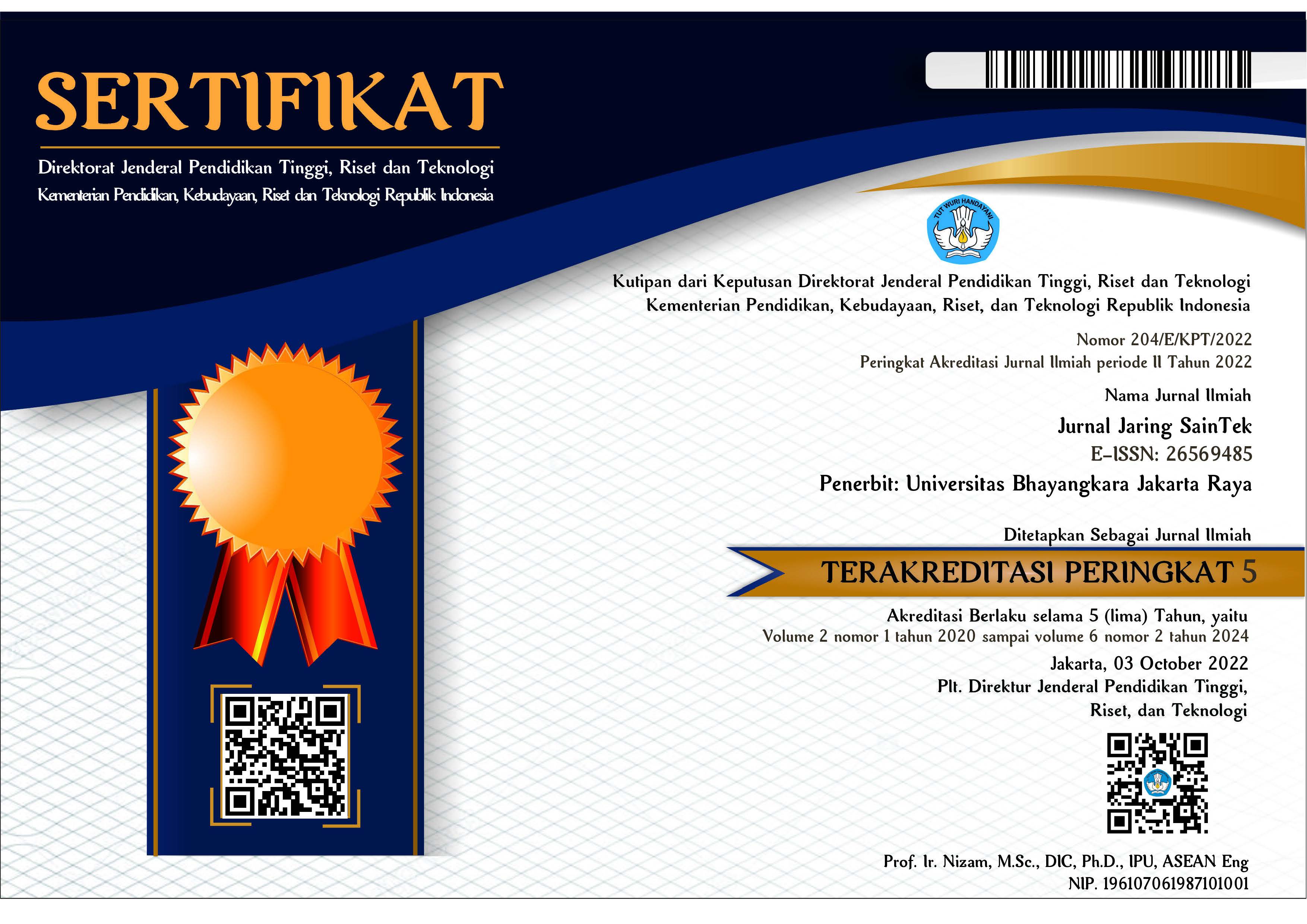Implementasi Algoritma SAW (Simple Additive Weighting) Dalam Pengambilan Keputusan Pembelian Mesin Produksi Pada PT Ardhi Karya Teknik
DOI:
https://doi.org/10.31599/jaring-saintek.v3i1.415Keywords:
SAW, decision making, effective, efficient, purchasing equipment,waterfallAbstract
- Ardhi Karya Teknik is a company engaged in construction, painting, cooling engineering and information technology. This company has difficulty in making decisions to buy equipment, especially for goods with a high enough value, because the goods purchased must meet certain criteria and be able to help the company's operations effectively and efficiently. This research was conducted to overcome the above, the method chosen in this study was SAW (Simple Additive Weighting) with the general stages: first entering data, second determining the weighting of each assessment criterion, third determining the best value of each criterion. , fourth calculates the value of the normalization matrix, fifth Calculate the final value for each data input by multiplying the normalized matrix with the weight matrix. The selected data is the data with the largest final value. Another method used in making an application is Waterfall. The SAW method is quite effective in assisting in decision making to purchase company operational support equipment.
Downloads
Download data is not yet available.
References
[1] H. Rohayani, “Analisis Sistem Pendukung Keputusan Dalam Memilih Program Studi Menggunakan Metode Logika Fuzzy,” J. Sist. Inf., vol. 5, no. Analisis Sistem Pendukung Keputusan, pp. 530–539, 2013.
[2] T. R. Adianto, Z. Arifin, D. M. Khairina, G. Mahakam, and G. Palm, “Di Perumahan Menggunakan Metode Simple Additive Weighting ( Saw ) ( Studi Kasus : Kota Samarinda ),” Pros. Semin. Ilmu Komput. dan Teknol. Inf., vol. 2, no. 1, pp. 197–201, 2017.
[3] D. Gustina and D. Mutiara, “SISTEM PENUNJANG KEPUTUSAN PEMILIHAN ROUTER MIKROTIK DENGAN MENGGUNAKAN METODE AHP (Analitycal Hierarchy Process),” J. Ilm. FIFO, vol. 9, no. 1, p. 68, 2017, doi: 10.22441/fifo.v9i1.1443.
[4] H. Ardiansyah, “Sistem Penunjang Keputusan Pemilihan Guru Terbaik dengan Metode TOPSIS (Technique for Order Preference by Similarity to Ideal Solution) Studi Kasus: SDN Bendungan Hilir 01 Pagi Jakarta Pusat,” J. Inform. Univ. Pamulang, vol. 2, no. 2, p. 89, 2017, doi: 10.32493/informatika.v2i2.1510.
[5] R. Gustriansyah, “Sistem Pendukung Keputusan Pemilihan Dosen Berprestasi,” Semin. Nas. Teknol. Inf. dan Komun., vol. 2016, no. Sentika, pp. 18–19, 2016, [Online]. Available: https://scholar.google.co.id/scholar?hl=id&as_sdt=0%2C5&as_vis=1&q=jurnal+issn+tentang+supplier+metode+anp&btnG=.
[6] I. Sadikin and U. Rusmawan, “Sistem pengolahan data penerimaan siswa baru dan pembayaran spp pada smk karya guna 1 bekasi,” Methodika, vol. 3, no. 1, pp. 251–257, 2017.
[7] B. Web Studi Kasus Pondok Pesantren Al-Habi Sholeh Kabupaten Kubu Raya and K. Barat Yoki Firmansyah, “Penerapan Metode SDLC Waterfall Dalam Pembuatan Sistem Informasi Akademik,” J. Teknol. Manaj. Inform., vol. 4, no. 1, 2018.
[8] D. S. Purnia, A. Rifai, and S. Rahmatullah, “Penerapan Metode Waterfall dalam Perancangan Sistem Informasi Aplikasi Bantuan Sosial Berbasis Android,” Semin. Nas. Sains dan Teknol. 2019, pp. 1–7, 2019.
[2] T. R. Adianto, Z. Arifin, D. M. Khairina, G. Mahakam, and G. Palm, “Di Perumahan Menggunakan Metode Simple Additive Weighting ( Saw ) ( Studi Kasus : Kota Samarinda ),” Pros. Semin. Ilmu Komput. dan Teknol. Inf., vol. 2, no. 1, pp. 197–201, 2017.
[3] D. Gustina and D. Mutiara, “SISTEM PENUNJANG KEPUTUSAN PEMILIHAN ROUTER MIKROTIK DENGAN MENGGUNAKAN METODE AHP (Analitycal Hierarchy Process),” J. Ilm. FIFO, vol. 9, no. 1, p. 68, 2017, doi: 10.22441/fifo.v9i1.1443.
[4] H. Ardiansyah, “Sistem Penunjang Keputusan Pemilihan Guru Terbaik dengan Metode TOPSIS (Technique for Order Preference by Similarity to Ideal Solution) Studi Kasus: SDN Bendungan Hilir 01 Pagi Jakarta Pusat,” J. Inform. Univ. Pamulang, vol. 2, no. 2, p. 89, 2017, doi: 10.32493/informatika.v2i2.1510.
[5] R. Gustriansyah, “Sistem Pendukung Keputusan Pemilihan Dosen Berprestasi,” Semin. Nas. Teknol. Inf. dan Komun., vol. 2016, no. Sentika, pp. 18–19, 2016, [Online]. Available: https://scholar.google.co.id/scholar?hl=id&as_sdt=0%2C5&as_vis=1&q=jurnal+issn+tentang+supplier+metode+anp&btnG=.
[6] I. Sadikin and U. Rusmawan, “Sistem pengolahan data penerimaan siswa baru dan pembayaran spp pada smk karya guna 1 bekasi,” Methodika, vol. 3, no. 1, pp. 251–257, 2017.
[7] B. Web Studi Kasus Pondok Pesantren Al-Habi Sholeh Kabupaten Kubu Raya and K. Barat Yoki Firmansyah, “Penerapan Metode SDLC Waterfall Dalam Pembuatan Sistem Informasi Akademik,” J. Teknol. Manaj. Inform., vol. 4, no. 1, 2018.
[8] D. S. Purnia, A. Rifai, and S. Rahmatullah, “Penerapan Metode Waterfall dalam Perancangan Sistem Informasi Aplikasi Bantuan Sosial Berbasis Android,” Semin. Nas. Sains dan Teknol. 2019, pp. 1–7, 2019.








